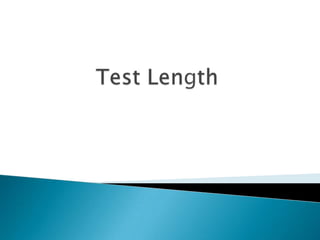Test length
•Download as PPTX, PDF•
0 likes•125 views
The document discusses factors that determine the length of time allowed for an exam, including the number of items, number of responses per item, and number of responses per examinee. It also lists common item types for selected response items, such as multiple choice, true-false, and matching. Finally, it provides guidelines for developing high-quality selected response items, such as using clear grammar and avoiding wordy stems or non-specific response options.
Report
Share
Report
Share

More Related Content
What's hot
What's hot (20)
Lesson Plan Handout and Template: Orange You Glad? (Math)

Lesson Plan Handout and Template: Orange You Glad? (Math)
Rubric reading comprehension questions and answers

Rubric reading comprehension questions and answers
Similar to Test length
Similar to Test length (20)
Test length
- 2. The length of time allowed to complete the exam is based upon the total number of items
- 3. Enough items to clarify the test's intention and replicate out a uni-dimensional variable. Enough person responses to each item to confirm item validity and provide a calibrated definition of the variable. Enough item responses by each examinee to validate the relevance of this examinee's performance.
- 4. Enough responses by each examinee to enable precise-enough inferences for the decisions for which the test was constructed and administered.
- 5. are items that require students to respond to a prompt by selecting an appropriate response, usually from answers that are provided.
- 6. Matching Multiple choice True-False
- 7. A. Format Use good grammar, punctuation, and spelling consistently. B . Content Avoid items based on opinions
- 8. C. Structure Avoid wordiness in the stem. D. Response Development Avoid the phrase “all of the above.” Avoid the phrase “none of the above.”
